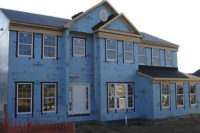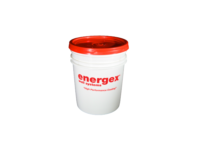
One of the key components of sustainable homes and buildings is a thermally efficient and dry building envelope that minimizes the leakage of air through the home. Air leaks in walls and attics decrease occupant comfort by permitting the entrance of cold or hot air, depending on the season. They can also contribute to low indoor air quality by allowing in dust and airborne pollutants, as well as water vapor, which can cause mold growth if trapped in wall cavities for too long. In addition, air leakage leads to higher utility bills. According to the U.S. Department of Energy, the average American household spends approximately $1,300 a year on energy used for heating and cooling and 25 to 40 percent of this energy is lost due to leakage in a typical residence.
To solve the air leakage problem, many of today’s contractors are taking a systems approach to insulation, installing products in wall cavities and attics that work together to impede air flow, reduce heat loss or gain and maintain a dry building envelope. Hybrid insulation systems combine the best attributes of two or more insulation products to provide a cost-effective airtight seal around the home as well as high thermal efficiency and superior moisture control. This leads to increased occupant comfort, improved thermal performance of the building envelope over the life of the home and makes the system a key component of an Energy Star rated home. Houses and buildings with hybrid insulation systems are extremely energy-efficient, which is good for the environment and reduces utility costs for the home or building owner.
One good example of a high-performance hybrid insulation system combines 1 inch of closed-cell spray foam insulation, fiberglass batt or blown-in insulation and a smart vapor retarder. In this article, we’ll take a closer look at each component, what it contributes individually and show how the components together can offer even more to the building envelope.

Closed Cell Spray Polyurethane Foam Insulation
Made from polyurethane, SPF insulation offers a thermal resistance of up to R 6.4 per one inch of installed thickness-one of the highest insulating values available on the insulation market today. It’s sprayed as a liquid into the intended area and expands to several times its initial size, filling crevices, gaps and other hard-to-reach spaces. This creates a very effective air barrier. In addition to excellent insulation attributes, applying SPF insulation to exterior walls and attic ceilings also provides additional structural support and racking strength.There are two types of SPF insulation-closed cell and open cell. Closed-cell SPF is comprised of tiny cells packed together tightly and inflated with a gas that causes the foam to expand. Closed-cell SPF is more durable than open-cell, has a higher R value and a stronger resistance to air and moisture and is the choice for high-performance hybrid systems.
One downside to using SPF as a stand-alone insulation is that it can have a significantly higher installed cost than fibrous insulations. A hybrid insulation system, however, gives homeowners the same air permeance performance by applying a 1- to 2-inch flash coat of closed-cell SPF. One inch is all that is needed, as SPF’s superior air resistance meets code-required air infiltration standards. The remaining portion of the wall cavity can then be filled with fiberglass batt or blown-in loose-fill fiberglass insulation.
Fiberglass Insulation
Fiberglass is the most commonly installed insulation material for a variety of reasons-it is readily available, easy to install, naturally fire-retardant and provides proven thermal resistance that won’t lose R value from settling. The flash coat of closed-cell SPF insulation in hybrid systems provides air sealing and allows fiberglass insulation to perform to its optimum level, rounding out the energy savings performance while providing unmatched acoustical performance.Many hybrid insulation systems call for fiberglass batts, since they are a very familiar product to all contractors. However, using a blown-in loose-fill insulation is an even more effective option and highly recommended, as it can fill more nooks and crannies and it can deliver a greater thermal performance than batt insulation.

Smart Vapor Retarder
Smart vapor retarders, made from a polyamide film, are a relatively new development in the building products industry and are known for their ability to change permeability with ambient humidity conditions. This process allows closed building envelope systems to help reduce the risk of mold and mildew problems by increasing their drying potential with seasonal climatic changes. With a high resistance to water vapor permeance throughout the winter, smart vapor retarders protect the hybrid cavity like traditional poly or kraft vapor retarders. But unlike traditional solutions, SVR can react to relative humidity by altering pore size, allowing water vapor to pass through it.When conditions change within the cavity-and relative humidity increases above 60 percent-the pores in the material expand and its permeability increases. This transformation permits drying to occur in the cooling season through the process of vapor diffusion. Thus, its lowered vapor permeance supports the drying process only when needed, which decreases moisture accumulation within the wall cavity as well as moisture damage and mold growth that can result.
Smart vapor retarders can be used in place of traditional vapor retarders with unfaced fiberglass insulation to provide an insulation system that is ideal in some of the more severe climate condition areas, in terms of both temperature and humidity. In addition, they may be installed as an interior air barrier system combined with recommended tapes and sealants. It is important to consult state building codes before installing, as vapor retarder placement can vary between climate zones.
Working Together as a System
A hybrid insulation system featuring closed-cell SPF insulation, blown-in fiberglass insulation and a smart vapor retarder provides a thermal protection and air and moisture resistance similar to that of a wall cavity filled with closed-cell SPF insulation. An insulated 5½-inch wall cavity with batt insulation alone would produce an R value of between 18 and 21. If the cavity instead had blown-in fiberglass insulation by itself, the R value would be about 23. With a hybrid system, the R value increases to 25 as well as a superior air barrier provided by the SPF.As stated earlier, one of the biggest selling points of a hybrid insulation system is its ability to reduce air infiltration while offering greater thermal performance and smart moisture control. Air sealing is required by most of today’s building codes, so why not expand your offering to include hybrid insulation systems and provide a more effective air seal and increased thermal resistance all in one system? In the long run, the benefits to the home or building owners will significantly outweigh a slightly higher installed cost. Hybrid insulation systems truly offer the best of both worlds in insulation performance.



Report Abusive Comment